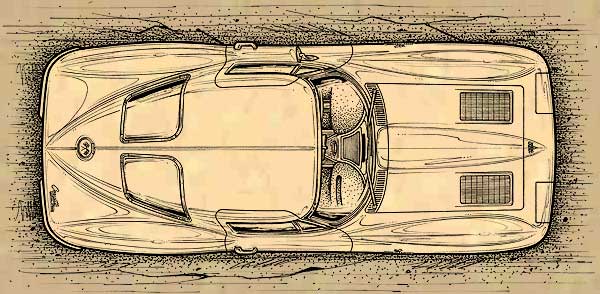Dateline: 5.16.12
The Illustrated Corvette Series “First” continues with a look back at the FIRST production Sting Ray.
 A few years ago, someone created a series of Chevrolet billboards using classic, iconic images of some of the most popular Chevrolet cars. Naturally, there were several layouts featuring Corvettes. While this is a totally biased opinion, I think the above “The Original American Idol” is the best. Four words sum it up perfectly and the back end of the one and only, split-window coupe says a thousand words.
A few years ago, someone created a series of Chevrolet billboards using classic, iconic images of some of the most popular Chevrolet cars. Naturally, there were several layouts featuring Corvettes. While this is a totally biased opinion, I think the above “The Original American Idol” is the best. Four words sum it up perfectly and the back end of the one and only, split-window coupe says a thousand words.
Our friend and VETTE Magazine founding editor, Marty Schorr, recently posted a review of the new 911 Porsche Carrera S at his CarGuyChronicles.com blog site. Writer, Howard Walker expounds on the fact that while the latest version of the classic 911 shares no hardware what-so-ever with the original and first ‘63 911, the spirit of the original 911 is still in tact. It’s an amazing combination of the rear-engine layout and the fact that the car still “looks” like a 911, only bigger and much better. I have often wondered what today’s Corvette would look like had Bill Mitchell never designed the game changing Mako Shark II. As I have written here in stories about Mitchell’s Mako Corvettes, the Mako Shark II was so astonishing, it simply HAD TO BE the next Corvette. End of conversation! And, we’ve moved on from there.
So, buckle up and lets take a blast back to 1963 for a look-see at the first production Sting Ray! – Scott
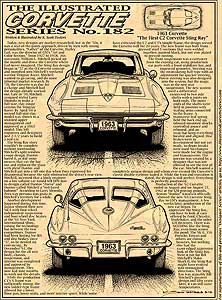 I call the Corvette the “The American Automotive Horatio Alger Story.” It’s the ultimate automotive rags-to-riches story. You could also call it an automotive Cinderella story. While the C6 has taken more flack than it deserves, it’s good to look back to the very beginning to get a really clear picture of how far the Corvette has come in 60 years. Today, new designs are market researched, but in the ‘50s, it was a seat-of-the-pants approach, driven by men with strong personalities. “Father” of the Corvette, Harley Earl, was the director of GM’s “Art and Color Section.” from 1927 to 1958. His successor, William L. Mitchell picked up the mantle and drove the Corvette where Earl never imagined.
I call the Corvette the “The American Automotive Horatio Alger Story.” It’s the ultimate automotive rags-to-riches story. You could also call it an automotive Cinderella story. While the C6 has taken more flack than it deserves, it’s good to look back to the very beginning to get a really clear picture of how far the Corvette has come in 60 years. Today, new designs are market researched, but in the ‘50s, it was a seat-of-the-pants approach, driven by men with strong personalities. “Father” of the Corvette, Harley Earl, was the director of GM’s “Art and Color Section.” from 1927 to 1958. His successor, William L. Mitchell picked up the mantle and drove the Corvette where Earl never imagined.
The Sting Ray design began in ‘57 as the Q-Corvette concept and morphed into Mitchell’s weekend warrior Stingray Racer. Mitchell wanted to go racing, and do some informal market research. By ‘59, the Corvette was due for a change and Mitchell had the design already worked out. Late in ‘59, Mitchell assigned stylist Larry Shinoda to make a full-size, clay coupe version the Stingray Racer. By April ‘60 a second full-size clay model was shown to a stunned upper management and approved as a 1963 model. This left engineers and designers just 2-1/2 years to build a real car.
The Sting Ray story wouldn’t be complete without mentioning Mitchell’s split-window coupe design. Duntov hated it, as did some owners that cut the bar out and replaced the glass with plexi! Duntov and Mitchell got into a tiff one day when Zora expressed his disapproval because the split obstructed the driver’s rear view. Mitchell, incensed that a lowly engineer on a low-volume car would tell HIM how to design, called Duntov “Zorro” and Duntov called Mitchell a “red-faced baboon!” According to Larry Shinoda, Zora was persona non grata in Mitchell’s territory for a while.
Another development happened during this time. Jaguar showed their new XK-E with four-wheel independent suspension and four-wheel disc brakes at the ‘61 New York International Show, raising the technology bar between the two competitors. Duntov had been lusting for IRS and disc brakes since ‘57, so he needed no convincing,. By December ‘61, the design for the all-new body, chassis, suspension, and interior was completed and approved by management. They now had nine months to work out the details.
While the production C1’s X-frame was sufficiently strong, the new ladder-type frame allowed for a lower floor pan, lower seats, and more interior space. While some have criticized the C2 and C3’s simple frame, the design served the Corvette well for 20 years. The new frame was built from pressed steel U-sections that were welded together, painted black, but not zinc plated to prevent rusting.
The front suspension was a carryover from the existing car, using production car parts with a front stabilizer bar, and improved geometry. Steering was the recirculating ball-type with an adjustment for quicker steering. Power steering was also designed into the system. But the magic was in the new rear suspension. The new system used a differential connected to two axle shafts with u-joints on both ends. The outer ends of the shafts were held in position with trailing arms connected to the frame. A transverse leaf spring held the back end up, inboard-mounted shocks controlled jounce and rebound, and an sway-bar keep everything located and aligned. Disc brakes were in development but not yet ready, so drum breaks were used No changes were made for the engine and transmission. The interior was created by a designer that was not allowed to see the rest of the car. Mitchell wanted a completely unique design and whom ever created the Corvette’s classic double eyebrow nailed it. While the trim and execution is dated, the design is still perfect. Everything is perfectly positioned.
Production of the ‘62 Corvette ended in August and on August 21, 1962 at the GM proving grounds, Semon “Bunkie” Knudsen officially showed the new ‘63 Corvette Sting Ray to GM’s management. A few weeks later, production of the new car began. To appreciate the Sting Ray, you have to look at cars offered by Ford, Chrysler, Studebaker, and the other GM divisions. There was NOTHING like the Sting Ray, even from across the pond. The XK-E, 356 Porsche, Ferrari and others are classic beauties, but nothing else had the razor-edged aggressive look of the Sting Ray. Were it not for Bill Mitchell’s Mako Shark-II, the Sting Ray might have evolved into unimagined directions. The Sting Ray was arguably Bill Mitchell’s greatest design and fifty years later, it can still raise temperatures. – KST
Related:
ATTENTION mid-year Corvette Sting Ray fans! We have THIRTY SIX 1963 Sting Ray and Grand Sport Art prints available HERE.
If Chevrolet was to make retro Corvettes, would billboards such as these help sell cars?, HERE.
Corvette Odd-Ball: A C2 Mid-year Sting Ray Lift-Back Coupe? HERE.
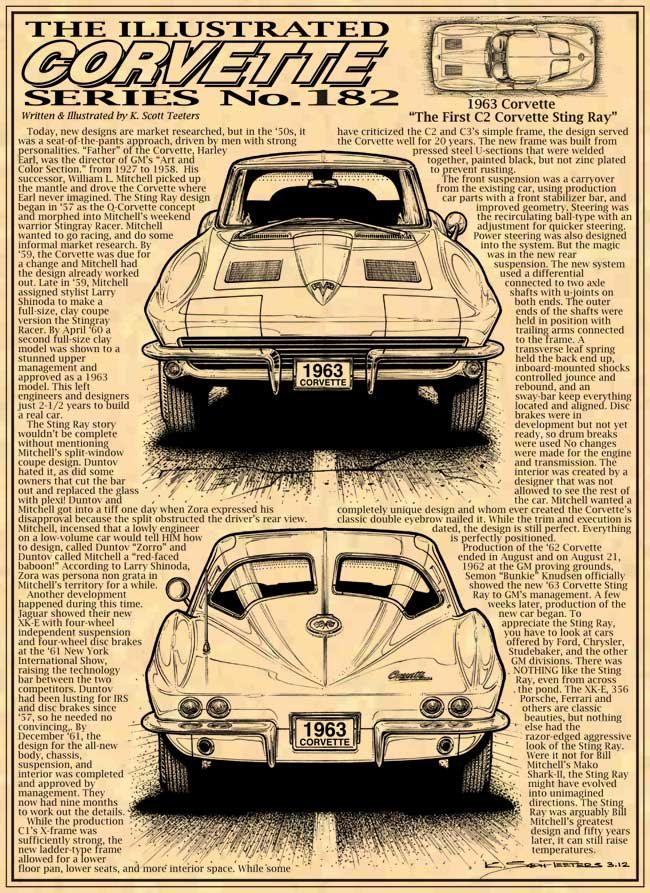 The above 11×17 Parchment Paper Print is available for just $24.95 + $6.95 S&H. Each print is signed and numbered by the artist. You can order your with the secure PayPal button below, or by calling 1-800-858-6670, Monday through Saturday 10AM to 9PM Eastern Standard Time.
The above 11×17 Parchment Paper Print is available for just $24.95 + $6.95 S&H. Each print is signed and numbered by the artist. You can order your with the secure PayPal button below, or by calling 1-800-858-6670, Monday through Saturday 10AM to 9PM Eastern Standard Time.
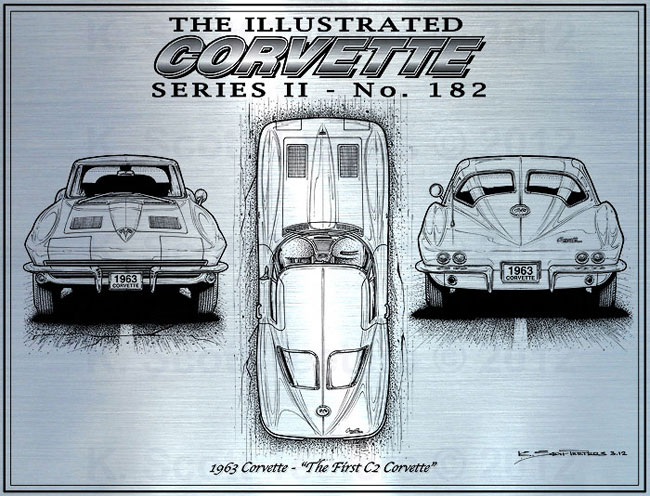 The above 11×17 Laser-Etched Print is available for just $49.95 + $8.00 S&H. Each printproduced on brush-finished, metalized mylar. You can order your with the secure PayPal button below, or by calling 1-800-858-6670, Monday through Saturday 10AM to 9PM Eastern Standard Time.
The above 11×17 Laser-Etched Print is available for just $49.95 + $8.00 S&H. Each printproduced on brush-finished, metalized mylar. You can order your with the secure PayPal button below, or by calling 1-800-858-6670, Monday through Saturday 10AM to 9PM Eastern Standard Time.
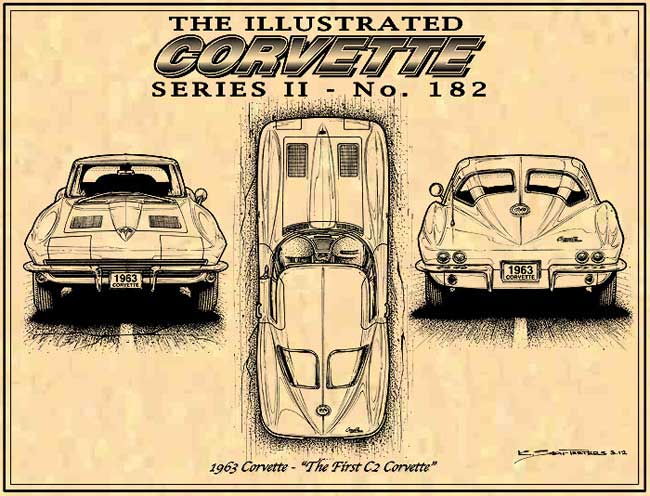 The above 11×17 Parchment Paper Print is available for just $24.95 + $6.95 S&H. Each print is signed and numbered by the artist. You can order your with the secure PayPal button below, or by calling 1-800-858-6670, Monday through Saturday 10AM to 9PM Eastern Standard Time
The above 11×17 Parchment Paper Print is available for just $24.95 + $6.95 S&H. Each print is signed and numbered by the artist. You can order your with the secure PayPal button below, or by calling 1-800-858-6670, Monday through Saturday 10AM to 9PM Eastern Standard Time
Here’s the BEST way to keep up with K. Scott Teeters’ Corvette blog!


